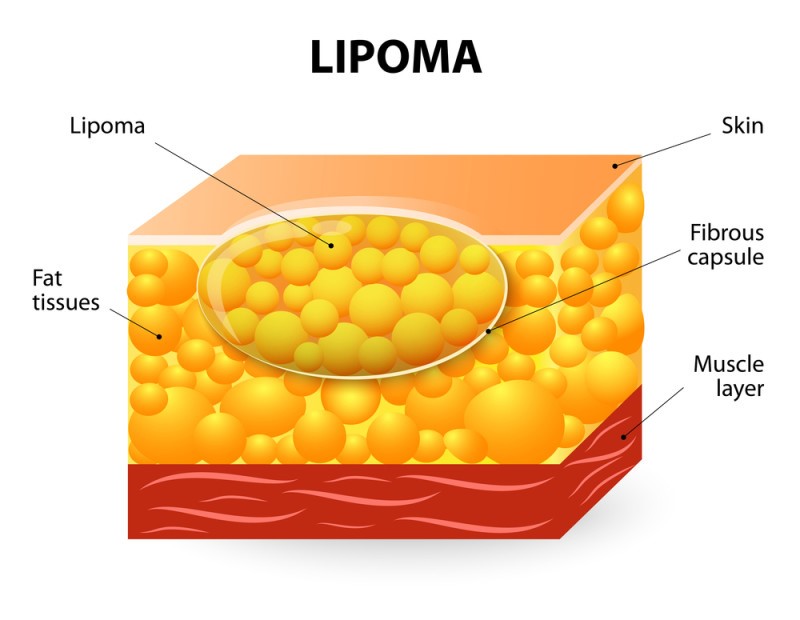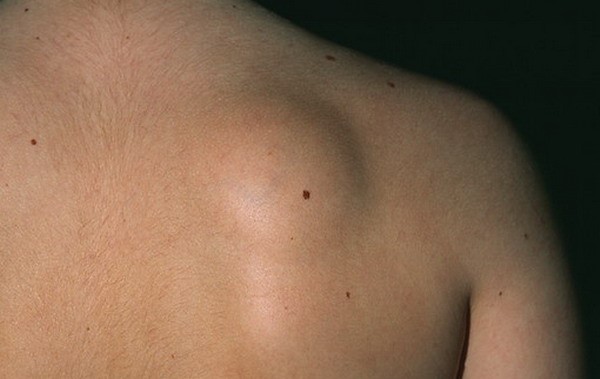Lipoma
A lipoma is a non-cancerous (benign) fatty lump that usually causes no symptoms or problems. Most lipomas are small and are best left alone. However, a lipoma that develops under the skin can sometimes look unsightly. If required, it can be removed by a simple operation done under anaesthetic.
Knowledge of a lipoma
A lipoma is a soft fatty lump. It is a non-cancerous (benign) growth made up from fat cells that clump together. A lipoma can occur in any part of the body where there are fat cells.

Large lipoma on the back
Lipomas typically feel soft and can be felt to move slightly under one’s skin when one presses on them.
Lipomas under the skin are the most common
Lipomas often form in the fatty tissue under the skin. These are also the most noticeable ones, as they look and feel like soft, dome-shaped lumps under the skin. They vary in size from pea-sized to several centimetres in diameter. The most common sites where lipomas develop are on the shoulders; the chest and the back but other areas of the skin can develop a lipoma.

Other parts of the body
Lipomas can less commonly form inside the body too. However, in most of these cases one will not be aware that one has a lipoma, as one cannot see them and they rarely cause any problems.
Proneness to lipomas and its prevalence
Anyone can develop a lipoma at any age. Lipomas are common. Some people inherit a tendency to develop lipomas and may have several on different parts of the body. Sometimes as many as 20 or more develop. However, it is more common to develop just one or two.
Lipomas can occur in people who are normal weight as well as people who are overweight.
Indications of a lipoma and its harmfulness
In themselves, lipomas are not serious and most lipomas cause no symptoms or problems. They grow very slowly. Sometimes a lipoma under the skin can be unsightly if it grows to be several centimetres across. Rarely, a lipoma may press on another structure and cause problems. For example, if one presses on a nerve it may cause pain. Also, rarely, a lipoma may develop in the gut wall and cause problems such as pain or a blockage of the gut.
Sometimes a scan or other investigation that is done for other reasons may detect a lipoma inside the body by chance. There is a condition called familial multiple lipoma in which groups of fat cells occur under the skin and then produce multiple fatty lumps. This is an uncommon condition and runs in families.
Note: lipomas are always benign. There is no scientific evidence that a lipoma increases the risk of developing a cancer in the future. However, lipomas can sometimes be mistaken for a cancerous tumour called a liposarcoma. These are usually large (5 cm or more in diameter) and grow rapidly.
Need for treatment on having lipoma
No treatment is needed usually. If one is not bothered by a lipoma that develops, then it is best just to leave it alone. However, some people want lipomas that are unsightly then LipomaTreatment/Lipoma surgery for cosmetic reasons. For example, if they occur on the face.
Occasionally, a lipoma needs to be removed if it is causing symptoms such as pressure symptoms. Sometimes a lipoma inside the body is LipomaTreatment/Lipoma surgery to look at under the microscope to make sure the growth that had been detected is a lipoma and not something more serious.
For a lipoma that forms under the skin, usually it can be removed by a simple LipomaTreatment/Lipoma surgery operation. Some local anaesthetic is injected into the skin over the lipoma. Once the overlying skin is numbed by the local anaesthetic, a cut (an incision) is made over the lipoma. The lipoma is then removed and cut away from the underlying tissue. The wound is then stitched up. A fine scar will be left.
